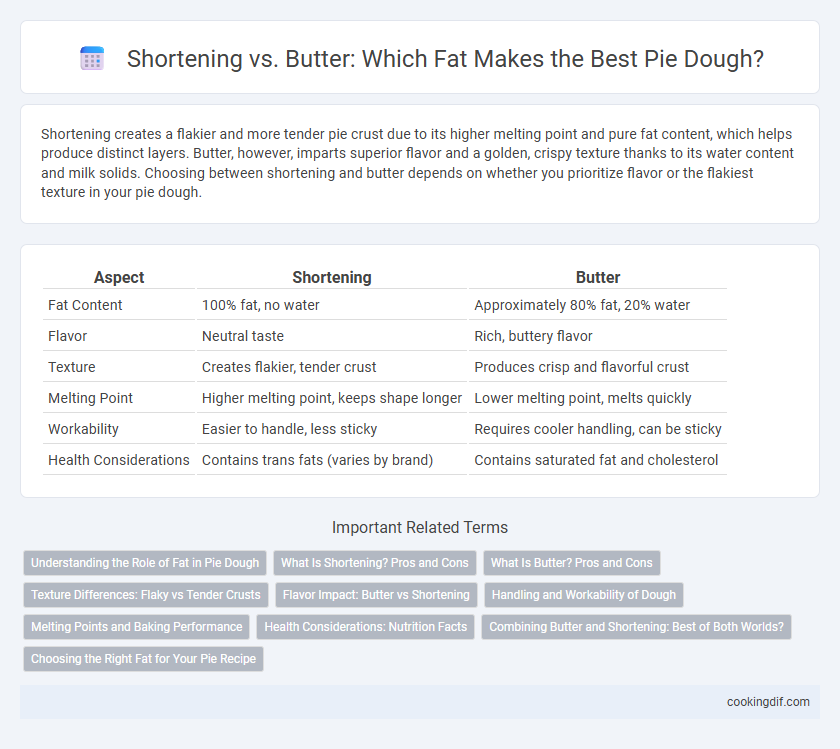Shortening creates a flakier and more tender pie crust due to its higher melting point and pure fat content, which helps produce distinct layers. Butter, however, imparts superior flavor and a golden, crispy texture thanks to its water content and milk solids. Choosing between shortening and butter depends on whether you prioritize flavor or the flakiest texture in your pie dough.
Table of Comparison
| Aspect | Shortening | Butter |
|---|---|---|
| Fat Content | 100% fat, no water | Approximately 80% fat, 20% water |
| Flavor | Neutral taste | Rich, buttery flavor |
| Texture | Creates flakier, tender crust | Produces crisp and flavorful crust |
| Melting Point | Higher melting point, keeps shape longer | Lower melting point, melts quickly |
| Workability | Easier to handle, less sticky | Requires cooler handling, can be sticky |
| Health Considerations | Contains trans fats (varies by brand) | Contains saturated fat and cholesterol |
Understanding the Role of Fat in Pie Dough
Fat in pie dough plays a crucial role in determining texture and flavor, with butter providing rich taste and a tender crumb due to its water content, which creates steam and flakiness during baking. Shortening, composed of 100% fat, contributes to a more tender and flaky crust by preventing excessive gluten formation but lacks the buttery flavor. Understanding the fat's melting point and moisture content helps in choosing the right fat to achieve a balance between flavor, texture, and ease of handling in pie dough.
What Is Shortening? Pros and Cons
Shortening is a solid fat made from vegetable oils, commonly used in pie dough to create a tender and flaky crust due to its 100% fat content, which prevents gluten formation by coating flour particles thoroughly. Its main advantage is the ability to produce consistent, light texture and better shelf stability compared to butter, which contains water and milk solids. However, shortening lacks the rich flavor of butter and may introduce a slightly greasy aftertaste, making it less desirable for those prioritizing taste over texture.
What Is Butter? Pros and Cons
Butter, a dairy fat made from churning cream, offers rich flavor and a tender, flaky texture ideal for pie dough. Its water content creates steam during baking, providing a light, airy crust but can lead to less stability compared to shortening. Butter's natural richness enhances taste, but it has a lower melting point and higher saturated fat, which may affect dough handling and shelf life.
Texture Differences: Flaky vs Tender Crusts
Shortening in pie dough produces a flaky crust due to its higher melting point and ability to create larger, distinct fat pockets that separate layers of dough during baking. Butter contributes to a more tender crust because its lower melting point releases moisture, resulting in a softer, richer texture with enhanced flavor. Combining both fats can balance flakiness and tenderness, optimizing texture and taste in pie crusts.
Flavor Impact: Butter vs Shortening
Butter imparts a rich, creamy flavor and a slightly sweet, dairy note to pie dough, enhancing the overall taste and aroma of the finished pie. Shortening, while providing superior flakiness and tenderness due to its 100% fat content, lacks the complex flavor profile of butter, resulting in a more neutral and less flavorful crust. Choosing butter over shortening significantly elevates the sensory experience with buttery undertones that complement both sweet and savory pie fillings.
Handling and Workability of Dough
Shortening creates a dough that is easier to handle and less sticky compared to butter due to its higher melting point and 100% fat content. Butter enhances flavor but can make the dough softer and more delicate, requiring careful handling to prevent tearing. Using shortening improves workability by providing a consistent texture that holds shape well during rolling and shaping of pie crusts.
Melting Points and Baking Performance
Shortening has a higher melting point (around 115degF) compared to butter (about 90degF), which helps create a flakier pie crust by preventing premature melting during baking. Butter melts faster, enhancing flavor and contributing to a tender texture, but can cause shrinking due to higher water content. Using a combination of shortening and butter balances the structural benefits and rich taste, optimizing both flakiness and flavor in pie dough.
Health Considerations: Nutrition Facts
Shortening contains zero grams of trans fat when labeled zero trans, providing a higher fat content with no cholesterol, which may benefit heart health by reducing saturated fat intake. Butter offers natural vitamins A and E along with essential fatty acids but contains higher levels of saturated fat and cholesterol, impacting cardiovascular risk. Choosing between shortening and butter influences calorie density and fat quality in pie dough, affecting overall nutritional value and health outcomes.
Combining Butter and Shortening: Best of Both Worlds?
Combining butter and shortening in pie dough enhances flavor and texture by balancing butter's rich taste with shortening's superior flakiness and moisture retention. This mixture creates a tender, flaky crust that holds shape better during baking, preventing shrinkage and sogginess. Using a 50-50 ratio optimizes the fat composition, delivering a crisp yet flavorful pie shell ideal for both sweet and savory fillings.
Choosing the Right Fat for Your Pie Recipe
Choosing the right fat for your pie dough impacts texture and flavor significantly; butter provides rich taste and crisp, flaky layers, while shortening creates tender, flaky crusts with more stability and less shrinkage. Butter's higher water content promotes steam creation for flakiness but can lead to tougher crust if overworked; shortening, being pure fat, offers easier handling and a lighter texture, ideal for delicate pies. For the best results, some bakers blend butter and shortening to balance flavor complexity and desirable dough consistency in pie recipes.
Shortening vs butter for pie dough fat Infographic

 cookingdif.com
cookingdif.com